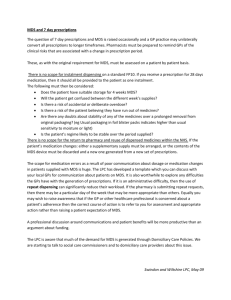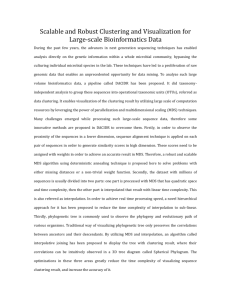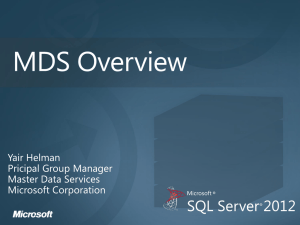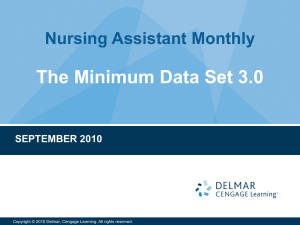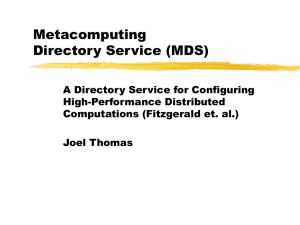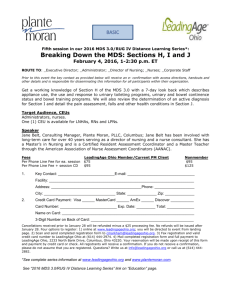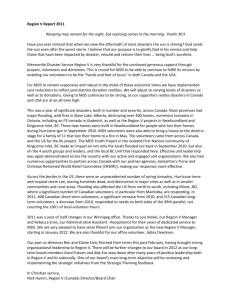Objectives Who Moved my Cheese?
advertisement
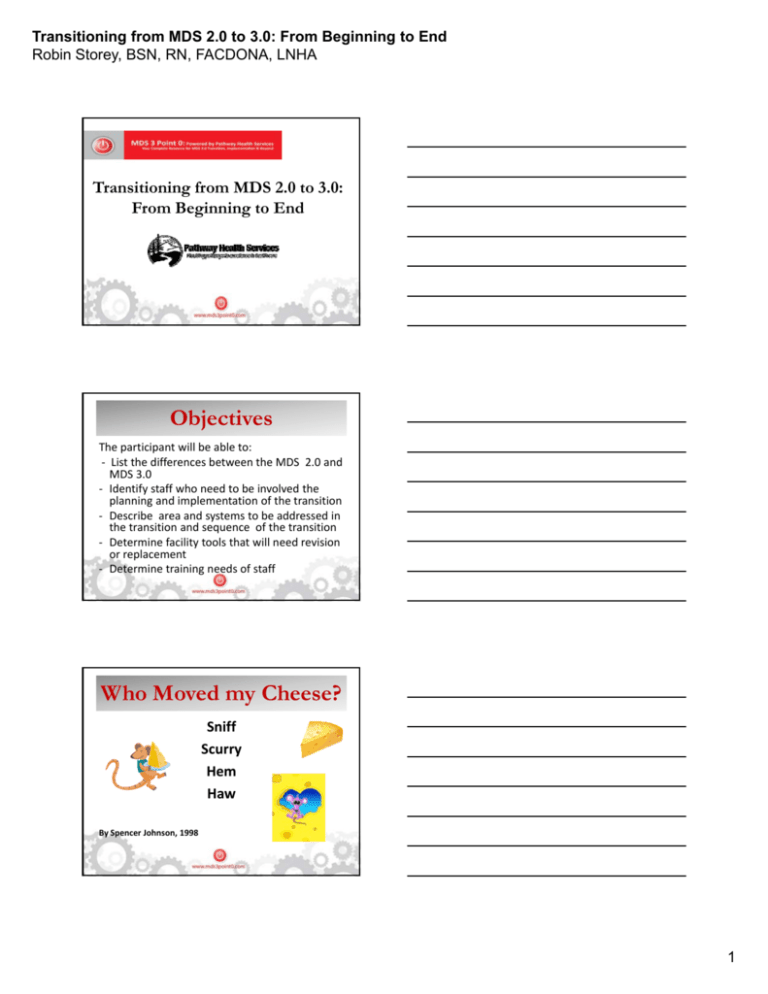
Transitioning from MDS 2.0 to 3.0: From Beginning to End Robin Storey, BSN, RN, FACDONA, LNHA Transitioning from MDS 2.0 to 3.0: From Beginning to End Objectives The participant will be able to: ‐ List the differences between the MDS 2.0 and MDS 3.0 ‐ Identify staff who need to be involved the planning and implementation of the transition l d l f h ‐ Describe area and systems to be addressed in the transition and sequence of the transition ‐ Determine facility tools that will need revision or replacement ‐ Determine training needs of staff Who Moved my Cheese? Sniff Scurry Hem Haw By Spencer Johnson, 1998 1 Transitioning from MDS 2.0 to 3.0: From Beginning to End Robin Storey, BSN, RN, FACDONA, LNHA Theories of System Change Change Six Sigma Lean Thinking Management Implement Reduce Remove Waste New Process’ Variation *Un‐Freeze *Change *Re‐Freeze *Define *Measure *Initiate *Analyze *Control *Identify Value *Identify Value Stream *Flow *Pull *Perfection Theory of Constraints Manage Constraints *Identify Constraint *Exploit Constraint *Subordinate Processes *Elevate Constraint *Repeat Cycle Theories of System Change • Change Management – Senior Management are “sponsors” – Instilling Need for Change in facility – Education and Training for Change Education and Training for Change – Coaching facility to effectively move through change – Monitoring to sustain the change AVOID MISTAKES • Learn from MDS ’87 • Don’t do what we did last time • • • • Ignore C Complain l i Pretend that it will go away More paperwork! 2 Transitioning from MDS 2.0 to 3.0: From Beginning to End Robin Storey, BSN, RN, FACDONA, LNHA TRANSITION “WELL” • Getting Started – Enthusiasm is Contagious – Visionaries, Detailers, and Everyone in‐between – Transition Process • Unfreezing – Changing the mindset from current to something different / Identifying another way/process • Changing – Doing it different, new system/process • Refreezing – Creating new habits and clear picture of new way Transition Planning Start from 30,000 FT End with all hands on deck! MDS 3.0 from 30,000 FT Biggest change in long term care in 12 years • Changes all aspects of facility’s…. • • • • • • • • Operations Clinical data Reimbursement b Resource allocation Budgeting Documentation Education Philosophical Change – Resident Center Care! 3 Transitioning from MDS 2.0 to 3.0: From Beginning to End Robin Storey, BSN, RN, FACDONA, LNHA MDS 3.0 from 20,000 FT • Start with the reasons why – Provider concerns that MDS 2.0 was not clinically up to date, valid & relevant. – Staff c/o time burden in completing the MDS 2.0 without clear benefit – Some items described as difficult or unclear – Resident / family concerns that MDS items were completed primarily by staff without their input. MDS 3.0 from 10,000 FT • Start with the reasons why – To make the MDS more clinically relevant, while still achieving the federal payment mandates and quality initiatives; – To improve ease of use and efficiency; – To integrate selected standard scales; and – To elicit resident voice by introducing interview questions. MDS 3.0 from 9000 FT • Start with the reasons why – To introduce advances in assessment measures – To increase user satisfaction & perception to help implement information into targeted care planning – To obtain more quality information in less time – To identify resident needs – To enhance communication among providers through inclusion of items recognized in other care settings 4 Transitioning from MDS 2.0 to 3.0: From Beginning to End Robin Storey, BSN, RN, FACDONA, LNHA MDS 3.0 • The draft MDS 3.0 was tested in 71 nursing homes in 8 different states. (3800 non VA residents were involved in various parts of the MDS) (2 gold standard reviewers per state & 1 facility reviewer per f ilit ) facility) • Driving the MDS 3.0 is the process of “Obtaining the Resident’s Voice”. This will be accomplished through resident interviews in order to identify the resident’s perception of their pain, functional, cognitive and emotional status. MDS 3.0 – The New Look • Appearance – 38 pages instead of 10 – Font bigger – Larger looking sections – Easier to read – Number system is different • Time to complete – 112 minutes‐old – 62 minutes – new MDS 3.0 from 8000 FT • New Manual is essential tool – Developed with Input from tool developers – Expert reviewers used – Experience gleaned from the MDS 2.0 considered Experience gleaned from the MDS 2 0 considered – Clearer coding instructions – Care Plan and Quality of Life Impact 5 Transitioning from MDS 2.0 to 3.0: From Beginning to End Robin Storey, BSN, RN, FACDONA, LNHA Overview of MDS 3.0 Manual Intent – Reason for including item in MDS Item display – Screen shots which display the item from MDS 3.0 item set Item Rationale – Purpose of assessing this aspect of resident’s clinical or functional status Health‐related Quality of Life – How the condition, impairment, improvement, or decline being assessed can affect quality of life, along with importance of staff understanding of relevance Overview of MDS 3.0 Manual • Planning for Care – How assessment of condition, improvement, impairment or decline being assessed can contribute to appropriate care planning • Steps for Assessment – Sources of information & methods for determining correct response for coding each MDS item • Coding Instructions – Proper method of recording each response, with explanations of individual response categories Overview of MDS 3.0 Manual, cont. Overview of MDS 3.0 Manual • Coding Tips and Special Populations – Clarifications, issues of note, and conditions to be considered when coding individual MDS items • Examples – Case examples of appropriate coding for most, if not all, MDS sections/items • Symbol is displayed in all MDS 3.0 for sections/ items that require a resident interview • Important definitions are highlighted in columns/glossary 6 Transitioning from MDS 2.0 to 3.0: From Beginning to End Robin Storey, BSN, RN, FACDONA, LNHA What the MDS? MDS 3.0isfrom 7000 FT • “Data Set” Primary Data Collection Tool – Core set of screening, clinical and functional status elements – Forms the foundation of assessment for all Forms the foundation of assessment for all residents in the SNF – Standardizes communication about resident conditions within the facility and externally between facilities and outside agencies MDS 3.0 from 6000 FT • Impact on Quality of Care – MDS reflects the condition of the resident on admission and as it changes through time. – It reflects the functionality of the resident as well as the stability of the resident’s condition. – It is black and white and reflects what really occurred without reason to why. – Drives the care plan and the care to be delivered. IMPACT: Inaccurate MDS could result in providing inappropriate care to the resident MDS 3.0 from 5000 FT • Impact on Quality Indicators and Quality Measures – Data from the MDS is used to compute the QI/QMs percentages. – This data is compares National, Regional, State to Facility – Data used in the Quality Assurance process‐ Data used in the Quality Assurance process identify identify areas needing fine tuning or revamping to improve the quality of care provided to the facility. Impact: If the data is incorrect the facility might be spending time and resources on systems that don’t need it while the other potential is that systems that need some revision go undetected. 7 Transitioning from MDS 2.0 to 3.0: From Beginning to End Robin Storey, BSN, RN, FACDONA, LNHA MDS 3.0 from 4000 FT • Impact on Compliance with Regulations – Standard Survey Process • The QI/QM report is downloaded by the survey team prior to entering the facility • Using this report the team will determine which areas appear to need investigation: – Such as Falls, Pressure Ulcers, Incontinence, Dehydration, Loss of Rom and Decline in Activities of Daily Living – Quality Indicator Survey • Phase I and Phase II – Roster Matrix!! • Accuracy of MDS and QI/QM – Verification MDS 3.0 from 3000 FT • Impact on Reimbursement – Medicare Reimbursement – Medicaid reimbursement – RUGs III and RUGs IV UGs a d UGs – Accuracy of MDS affects reimbursement – MDS Process Affects Reimbursement – ARDs – What a difference a day can make! RUGS from 2000 FT MDS 2.0 MDS 3.0 RUGS III RUGS IV Case Mix Index Medicare 53 Levels Case Mix Index Medicare 66 Levels 8 Transitioning from MDS 2.0 to 3.0: From Beginning to End Robin Storey, BSN, RN, FACDONA, LNHA MDS 3.0 from 1000 FT • Impact on the 5‐Star Rating – MDS Data is used for 2 of the 3 areas • QI/QM • Health Inspections Health Inspections Impact: With inaccurate data in the Quality Measures the star rating applied to the QMs could potentially lower the Overall Star Rating for a facility and a potential decline in census! MDS 3.0 from Ground Level • Summary: – Increased Accuracy – Increased Clarity – Increased clinical relevance Increased clinical relevance – Decrease time by 45% – Brings standard assessments to the tool Transition with Budget and Resource Allocation 9 Transitioning from MDS 2.0 to 3.0: From Beginning to End Robin Storey, BSN, RN, FACDONA, LNHA Transition: Budget and Resources • Budget Implications of the MDS 3.0 – Training: Initial and Ongoing – Meetings: IDT Team, All staff In‐services, Time with Resident for Interviews with Resident for Interviews – Hardware and Software Enhancements – Manuals and updates Transition: Budget and Resources • Time and Resources for the MDS 3.0 – Studies estimate a 45% time savings over the MDS 3.0 – But…There are added discharge assessments But There are added discharge assessments – Recommend System Specialist to oversee their sections of the MDS (e.g. Pain Specialist) – Oversight and supervision of completion of supporting documentation charting sections Transition by Establishing g MDS 3.0 Team 10 Transitioning from MDS 2.0 to 3.0: From Beginning to End Robin Storey, BSN, RN, FACDONA, LNHA Transition Team • Determine Team Process – – – – Assign MDS 3.0 Transition Team Establish Team Meeting Schedule (one hour/wk) Use checklist Use checklist Use Meeting Action Plan Document Transition Team • Team Personality Types – Agitator: questions everything, sparks innovation – Wild Card: Adds skill and dedication to process – Leader: Executes process Leader: Executes process’, gets teams moving gets teams moving – Workhorse: Focus, Determination – Glue: Brings team together, encourager when things get tough – Expert: Brings solutions and information to process By: Jeff Palfini www.BNET.com Transition Team Who should be involved? – Administrator – Director of Nursing – MDS/Medicare Nurse – Social Service – Therapy – Business Office – Activities – Nutritional Services – IT Administrator – Unit Managers – Others… 11 Transitioning from MDS 2.0 to 3.0: From Beginning to End Robin Storey, BSN, RN, FACDONA, LNHA Transition Team System Issue Action to be taken Who is responsible Date Due @ @ @ @ Transition Team • Team Responsibility: – Assist facility to move toward Culture Change – Improving Resident Quality of Life – Analyze current processes Analyze current processes – Devise flow to new processes – Develop a Transition Calendar to aid in target setting Transition Team • Team Responsibility – Keep the MDS 2.0 going while learning the new process – Divide the MDS 3.0 Sections among team Divide the MDS 3 0 Sections among team members for review and system revisions – Have a software vendor liaison – Brainstorming the possibilities… 12 Transitioning from MDS 2.0 to 3.0: From Beginning to End Robin Storey, BSN, RN, FACDONA, LNHA Transition Team • Team Responsibility – Restructuring to meet new work flow needs and resident care initiatives – Structure the Resident Interview Process Structure the Resident Interview Process Effectively – Budget Training (off‐site, on‐site) – Budget Software Changes Transition by Assessment and Supporting Documentation Review Transition Assessments • Review MDS Assessments and Documentation System • • • Current system mapping Identify areas that you aren’t currently capturing data on or areas that require different data to be retrieved. Determine what tools you currently use and decide if new or revised tools are necessary. • (e.g. Mood/behavior) • (e.g. ADL tracking) 13 Transitioning from MDS 2.0 to 3.0: From Beginning to End Robin Storey, BSN, RN, FACDONA, LNHA Transition with Work Flow Process Analysis Transition: Work Flow • Workflow Process Written plan for which team members complete each sections of the MDS – Written forms and established communication techniques to be used in the MDS 3.0 process – Mapped out MDS 3.0 timelines and completion dates • Start/Stop Therapy Assessments • Discharge Assessments • OBRA Timeframes based on ARD • Transmissions by day 14 after completion date – Transition Takes New Skill Sets for MDS Coordinators and the IDT SYSTEMS REVIEW 14 Transitioning from MDS 2.0 to 3.0: From Beginning to End Robin Storey, BSN, RN, FACDONA, LNHA Transition: Roles and Skill Sets • Ensures that Resident Voice is driving care planning • Oversees integration of Resident’s care goals • Provides critical thinking to comprehensive care management, keeping the “big management, keeping the big picture picture” in mind in mind • Draws direct caregiver information into the care planning process • Utilizes “experts” in RAI processes to ensure clinical standards of care are met Transition: Resident Interview • 5 Resident Interviews 1. BIMs (Brief Interview for Mental Status) ‐ Section C, form page 6 of 38 2. PHQ‐9 (Patient Health Questionnaire) ‐ Section D, form page 8 of 38 3. Activities of Daily Living Preference and 4. Activity Preferences ‐ Section F, page 12 of 38 5. Pain ‐ Section J, page 19 of 38 Transition: Resident Interview • Resident Interviews are feasible • Residents with moderate cognitive impairment – Can accurately answer simple interview questions about what they want and how they feel. – Also true for some residents with severe cognitive impairment. • It is estimated that over 85% of residents can communicate about their sadness, pain, daily routine and desired activity level 15 Transitioning from MDS 2.0 to 3.0: From Beginning to End Robin Storey, BSN, RN, FACDONA, LNHA Transition: Resident Interview • Responses can be entered directly on the MDS and it is complete – • Retrieving data from multiple sources is only necessary for those residents who, although approached, cannot participate in answering the interview questions. ti i t i i th i t i ti Interviews can be the sole source for information – – Can provide more accurate information Is efficient Transition: Resident Interview • Key Concepts Recommend that only trained interviewers conduct them Interviews cannot be rushed Listen twice as much as you talk!!!!! Ask clarifying questions Use observation skills to watch for uneasiness, signs of delirium etc. – Make sure resident has had opportunity to toilet etc. – Make it an intimate setting such as sitting close etc. – – – – – Transition: Resident Interview • Key Concepts – Provide an interpreter if needed or wanted – Provide privacy for interview – Use large print written cue cards to show answer g p choices – Use the knowledge of vision and hearing abilities of resident to sit on the best side, use loud voice etc. – Share that you need to take notes so you can remember their answers to be accurate 16 Transitioning from MDS 2.0 to 3.0: From Beginning to End Robin Storey, BSN, RN, FACDONA, LNHA Transition: Resident Interview • Interview Skills Detangling – break questions up into smaller ones Unfolding – start at broader answer and narrow to specific – Echoing – summarize long answers – Probing – ask open ended questions • Use the QIS Resident Interviews (to supplement information gathered from the resident) – – Transition: Resident Interview • BIMs (Brief Interview for Mental Status) – Repetition of three words: sock, blue, and bed – Code refusals to answer as “incorrect” – C0200 Repeated words after C0200 Repeated words after “FIRST” FIRST attempt attempt – C0300 Ask “year”, “month”, “day of week” – C0400 Recall – can provide clues Transition: Resident Interview • PHQ‐9 (Patient Health Questionnaire) – – – – – Asks nine questions 14 day look back Do not provide definitions because answers must be p based on resident’s interpretation Code regardless of whether Resident or Assessor attributes the symptom to other than mood Code to the highest frequency of mood symptom if multiple frequency is given 17 Transitioning from MDS 2.0 to 3.0: From Beginning to End Robin Storey, BSN, RN, FACDONA, LNHA Transition: Resident Interview • Activities of Daily Living Preference and Activity Preferences – Each section Asks eight questions – Attempt to interview Resident, Family or Attempt to interview Resident, Family or Significant other – Stop the interview if Resident gives nonsensical answers or doesn’t answer three questions Transition: Resident Interview • Pain Interview – Five questions – 5‐day look back or ask Resident to think about most recent pain episode and try to determine if i it occurred in look back period di l kb k i d – J0600 Pain Intensity – Teach Resident scale definitions, use 0‐10 pain scale or the verbal description scale – Rates of self‐report pain are higher than observed pain Transition: Care Systems • Section B, Hearing, Speech, and Vision Which discipline should code this section? Comatose – physician written diagnosis required Hearing – functional ability Speech Clarity ‐Resident’s ability to verbally make needs know – Makes Self Understood – impacts risk for isolation, mood, and behavior – Ability to Understand others – (not related to language) – Vision – no diagnosis assessment, only ability to see – – – – 18 Transitioning from MDS 2.0 to 3.0: From Beginning to End Robin Storey, BSN, RN, FACDONA, LNHA Transition: Care Systems • Section C, Delirium Assessment – – – – – – “CAM”, Confusion Assessment Method Four Item Assessment Delirium can be misdiagnosed as Dementia Prompt detection is essential to prevent permanent impact Assess daily to improve level of detection (for new admissions) Ask the resident to count backwards from 20 to assess attention Transition: Care Systems • Section E, Behavior Management Programming – Code based on “WHAT” not “WHY” (not intent) – Replaces alterability with specific impact questions such as disruptive, intrusive, risk for injury of self and others, and impeding care goals – Uses Rejection of Care vs. Resistive of Care – Key is to determine if the rejection of care is consistent with Res. Preferences or goals – Wandering and Pacing coded in this section Transition: Care Systems • Section G, Activities of Daily Living, Assessing Function – Radically different with column 1 & 2 ! – Clearer definitions of “Rule of 3” – Self‐performance adds a “7” code for self‐ performance – RUGs IV uses late loss ADL’s, but scores “8” activity did not occur as a “0”! Highest impact is in Transfers. – Excludes care done by therapist, family, and visitors 19 Transitioning from MDS 2.0 to 3.0: From Beginning to End Robin Storey, BSN, RN, FACDONA, LNHA Transition: Care Systems • Section G, Balance During Transitions and Walking (five items) – Move from sitting to standing, Walking 15 ft, turning around, moving on/off toilet, and surface to surface transfers (chair to bed) – Can be formally assessed or observed in environment – Document assessment and observation – Code for the least steady episode Transition: Care Systems • Section H, Bladder and Bowel Programming • Bladder Continence – count episodes • Urinary Toileting Program – success of previous trial – Documentation must prove – Individualized, staff knows about program and resident response about program and resident response • Bowel continence (7 days vs. 14 days) • Bowel Toileting Program – suggests care plan for fluid intake, fiber, exercise and toilet schedule • No Fecal Impaction, but expanded definition for Constipation Transition: Care Systems • Section I, Active diagnosis, Disease Management – TWO STEP process • Step 1 – Identify physician documented diagnosis in last 60 days • Step 2 – Identify if the diagnosis related to functional status, cognition, mood, behavior, medical treatments, nursing monitoring, or risk for death 20 Transitioning from MDS 2.0 to 3.0: From Beginning to End Robin Storey, BSN, RN, FACDONA, LNHA Transition: Care Systems • Section J, Accident Prevention, other – Fall history – highest predictor of risk – Fractures related to falls – Falls coded by type of injury Falls coded by type of injury Transition: Care Systems • Section J, other – – – – – – Shortness of Breath while sitting, exertion, lying flat Current Tobacco Use Fever: 2.4 degrees over baseline or 100.4 on g admission Dehydration: two or more of: less than 1500 ml of fluid, one or more clinical signs, or fluid loss Internal bleeding Six months or less to live: physician diagnosis Transition: Care Systems • Section K, Nutrition Health Programming Shortened and simplified Swallowing Disorder – not coded if compensated Use Mathematical Rounding for height and weight Weight Loss changes • New definition of 5% weight loss • MD prescribed weight loss regimen – Nutritional Approaches • New definitions • IV fluids administration for nutrition/hydration – – – – 21 Transitioning from MDS 2.0 to 3.0: From Beginning to End Robin Storey, BSN, RN, FACDONA, LNHA Transition: Care Systems • Section M, Skin Conditions – Pressure Ulcers • Is the resident at RISK for PU’s? • New definitions – New definitions – NPUAP recommended NPUAP recommended • New Criteria – hospital acquired, diabetic foot ulcers, previously noted PU – Staging provides a description of extent of visible tissue damage and informs expectations for healing times Transition: Care Systems • Section N, Medication Management – 9+ Meds is eliminated – Insulin Definition changes (RUGs IV impact) • Section O, Special Treatments and Procedures p – – – – – Chemo, Radiation O2, IV Medications Suctioning BiPap/CPap Isolation (does not include standard body/fluid precautions) Transition: Care Systems • Section O, Therapy Programming – Includes start dates ‐ date most recent therapy regimen (since last assessment) started – Includes end dates of therapy ‐ date most recent therapy regimen (since last assessment) ended i (i l t t) d d – Enter dashes if therapy is ongoing – Code only medically necessary therapies – Include only if after admission/readmission to facility – Based on qualified therapist’s assessment after admission/readmission 22 Transitioning from MDS 2.0 to 3.0: From Beginning to End Robin Storey, BSN, RN, FACDONA, LNHA Transition: Care Systems • Section O, Therapy Programming – – – – – – Can occur inside or outside facility 15+ minutes = 1 day of therapy, <15 minutes/day = 0 days of therapy Re‐eval minutes count Count only uninterrupted time Set up equipment time included Transition: Care Systems • Section O, Therapy Programming – Do not include non‐skilled services that are not medically necessary – If maintenance services performed by non therapists, do not include here (include under Restorative Nursing not include here (include under Restorative Nursing Program if applies) – Co‐treatment‐2 clinicians from different disciplines , treating 1 resident at same time, must split the time between the 2 disciplines Section OCare – Therapies! Transition: Systems • Section O, Therapies breakdown included for: 1) Individual Minutes 2) Concurrent Minutes – Part A: 2 residents at same time while performing 2 different activities, regardless of payer source and in line‐of‐sight of treating therapist or assistant treating therapist or assistant – Part B, may not be treated concurrently 3) Group Minutes – Part A: 2‐4 residents, regardless of payer source, performing similar activities, supervised by a therapist or assistant who is not supervising any other individuals – Part B: Treatment of 2 residents at same time, regardless if same or different activities 23 Transitioning from MDS 2.0 to 3.0: From Beginning to End Robin Storey, BSN, RN, FACDONA, LNHA Other Care Changes Transition: Systems – Includes start dates ‐ date most recent therapy regimen (since last assessment) started – Includes end dates of therapy ‐ date most recent therapy regimen (since last assessment) ended – Enter dashes if therapy is ongoing Enter dashes if therapy is ongoing – Code only medically necessary therapies – Include only if after admission/readmission to facility – Based on qualified therapist’s assessment after admission/readmission – Can occur inside or outside facility Transition: Care Systems • Section O, Restorative Nursing – Training and Skill Practice to improve or maintain functional goals – Planned, Scheduled, Documented Programs – RN or LPN must supervise the activities RN or LPN must supervise the activities – Any participation by Resident in ROM is coded as “Active” Transition: Care Systems • Section O, Restorative Nursing – Continuous Passive Motion devices can be included when criteria is met – Residents with Dementia learn skills best through repetition that occurs multiple times a day repetition that occurs multiple times a day – Nursing Assistants can write a progress note that is cosigned by the licensed nurse 24 Transitioning from MDS 2.0 to 3.0: From Beginning to End Robin Storey, BSN, RN, FACDONA, LNHA Transition: Care Systems • Section O, Physician Visits, Physician Orders – Number of DAYS the resident had a partial or full exam – Exam documented in progress note required p g q – Orders written to increase the RUG classification and facility payment are not acceptable – Orders for transfer of care to another physician may not be counted – Orders written by pharmacists are not included Transition: Care Systems • Section P, Restraint Programs – Restraint Free Environment not Required – Restraints have a limited role in medical care – Medical need, indicating symptoms, and gradual Medical need, indicating symptoms, and gradual reduction practice is required – Physical or Mechanical Equipment adjacent to the resident body that cannot be removed easily, restricts freedom of movement, or limits access to ones body Transition: Care Systems • Section V, Care Area Assessments (CAAs) – Triggered by the CATs (Care Area Triggers) – CATs are detailed in Chapter 4 of the User’s Manual – 20 CAA’s including the former 18 plus Pain and Return to Community – CAA Resources – helpful resources in Appendix C • Not all‐inclusive nor government endorsed list – Care Systems are impacted by effective overview and critical thinking in the CAA analysis process 25 Transitioning from MDS 2.0 to 3.0: From Beginning to End Robin Storey, BSN, RN, FACDONA, LNHA Transition: Scheduling • 11 Assessment Forms called, “Item Sets” – – – – – – – – – MDS all item listing Set and Comprehensive sets (38 pages) NH /SB Discharge Items (27 pages) NH/SB OMRA Items (20 pages ) NH/SB OMRA Discharge Items (32 pages) NH PPS Set and NH Quarterly Set (33 pages) NH/SB OMRA –Start of Therapy (12 pages) NH/SB OMRA Start of Therapy and Discharge (29 pages) NH/SB Tracking (8 pages) Swing Bed PPS (33 pages) Transition: Scheduling • Transmission Process – Transmissions will go to the Federal Repository called the Quality Improvement Evaluation System (Qies) Assessment Submission and Processing (ASAP) system – Transmission times require MDS’ to be sent to the ASAP no T i i ti i MDS’ t b t t th ASAP later than 14 days from the completion date – A comprehensive assessment including writing CAA’s is required every 366 from the Assessment Reference Date (ARD) of the last comprehensive assessment – Quarterly assessments are required every 92 days from ARD to ARD Transition: Scheduling • Completion Timing: – For all Federal/OBRA and PPS assessments, the MDS Completion Date (Z0500B) may be no later than 14 days from ARD – For Admission Assessment, the Care Area Assessment F Ad i i A t th C A A t (CAA) Completion Date (V0200B2) should be no more than 14 days from either the date of admission (initial entry) or the date of reentry (in the event that there was a prior temporary discharge after the initial entry and before completion of the Admission Assessment), whichever is later 26 Transitioning from MDS 2.0 to 3.0: From Beginning to End Robin Storey, BSN, RN, FACDONA, LNHA Transition: Scheduling • Correction Assessments – Comprehensive MDS assessments, Annual assessment updates, Significant Change in Status assessments, and Significant Correction to Prior Comprehensive assessments, the CAA Completion date may be no later p y than 14 days from the ARD – Entry, discharge to community, discharge to another facility, or discharged deceased, a subset of items must be completed within 14 days of the Event Date (A1600 for an entry; A200 for a discharge) Transition: Scheduling • PPS Other Medicare Required Assessment (OMRA) – Start of therapy assessment: with an ARD 5‐7 days after 1st day therapy services are provided – End of therapy assessment: with an ARD that is 1‐3 days after the last day therapy services were provided ft th l t d th i id d – Both the start & end of therapy assessment: with ARD both 5‐7 days after the 1st day therapy services were provided and that is 1‐3 days after last day therapy services were provided Transition: Scheduling • Special Note: HOSPICE If resident elects Medicare hospice benefits, facilities are required to complete a significant change in , status assessment, even if a recent MDS was done and the only change is the election of the hospice benefit 27 Transitioning from MDS 2.0 to 3.0: From Beginning to End Robin Storey, BSN, RN, FACDONA, LNHA Transition: Managing RUGs • • State Requirements Medicare: 66 RUGs – – – – The most important criteria is setting the ARD S Second in importance is ADL scoring di i i A L i PT, OT, and ST minutes Will see greater focus on skilled nursing and low rehab TRANSITION STRATEGIES The number of RUG categories will increase from 53 to 66 • Special Care category will split into two separate categories: – Special Care High – Special Care Low • Impaired Cognition and Behavior categories combine – Behavioral Symptoms – Cognitive Performance • New qualifiers: – Rehabilitation Plus Extensive Services – Extensive Services – Clinically Complex categories TRANSITION STRATEGIES • Adjustments to ADL index: – RUG‐IV ADL score ranges from 0 to 16 – RUG‐III ADL score ranges from 4 to 18 – Revisions to “eating” ADL score • Residents who receive feeding assistance • Revisions to calculation of therapy minutes • Modified look‐back period for items – Special Treatments and Procedures – Only those services provided while patient is a resident of the SNF 28 Transitioning from MDS 2.0 to 3.0: From Beginning to End Robin Storey, BSN, RN, FACDONA, LNHA Proposed RUGs IV Classification Elements Transition with Strong Software Vendor Relationship Transition: Software Updates • Software Vendor Issues – Will your software be updated? – Will the computer vendor need to develop a new software? • Identify when software will be updated Identify when software will be updated • Will it meet your needs • Do you need electronic charting • Is there any cost to you for upgrades/training • Interest in software changes – (online ADL charting) – What needs do you have regarding software/medical records? 29 Transitioning from MDS 2.0 to 3.0: From Beginning to End Robin Storey, BSN, RN, FACDONA, LNHA Transition Using Policies and Procedures Transition: Policies and Procedures • Policy and Procedure Manual Revisions – Policy and Procedure Manual Updates • • • Identify the MDS Policy and Procedures – Revise as needed based on work by team Review all policy and procedure manuals for reference to the MDS process – Revise as needed to reflect MDS 3.0 All team members should read pertinent sections of new MDS 3.0 RAI Manual – Familiarize new format, descriptions, item coding patterns, etc. Transition with Staff Training 30 Transitioning from MDS 2.0 to 3.0: From Beginning to End Robin Storey, BSN, RN, FACDONA, LNHA Transition: Staff Training • Training Schedule – Who will be the trainers: DON, MDS Coordinator – What needs to be trained • New form and process not just revisions New form and process not just revisions • Interview techniques • MDS sections • How to code the MDS/Intent and meaning • New documentation tools Transition: Staff Training • Training Schedule – Who will be trained – MDS Coordinator – MDS team members MDS team members – Facility staff – When and where will staff be trained » Onsite » Off site Transition with MDS 3.0 Trial Completion 31 Transitioning from MDS 2.0 to 3.0: From Beginning to End Robin Storey, BSN, RN, FACDONA, LNHA Transition: MDS 3.0 Trials • Trial Completion of the MDS 3.0 • All team members should read pertinent sections of new MDS 3.0 RAI Manual – Familiarize new format, descriptions, item coding patterns, etc. tt t • Complete the MDS 3.0 Form – When to introduce sections – Practice sections – Use the information Transition with Auditing for Success Transition: Auditing for Success • Establish Audit Process – Audit current case mix for accuracy • ADL’s • Assessment Reference Dates A f – Audit for new RUGs • Compare current RUG to new RUG – Track new RUGs over time (ADL scores, Therapy Minutes, short stay, etc.) 32 Transitioning from MDS 2.0 to 3.0: From Beginning to End Robin Storey, BSN, RN, FACDONA, LNHA Transition: Auditing for Success • 66 RUGS IV Audit Tool – What is needed to conduct this review: • Listing of current RUGs levels for residents • Select a sample of records for review Select a sample of records for review • Understanding of MDS 2.0 and MDS 3.0 tools • Understanding of RUGs III and RUGs IV • Completion of enclosed tool Summary of Trip, Transition: Auditing forcont. Success • Compliance and Monitoring – Audits • Identify sections of MDS 3.0 that require audits • Identify key staff to conduct audits per schedule – Develop a QA plan for the 3.0 process • Practice audits • Routine monitoring of accuracy • QA Committee to Oversee QA process as it relates to MDS 3.0 Implementation and Compliance 33 Transitioning from MDS 2.0 to 3.0: From Beginning to End Robin Storey, BSN, RN, FACDONA, LNHA Transition Using Quality Assurance Planning Transition: QA Programming • During the transition to MDS 3.0 QI/QM data will not be available for about six months • Keep up the Survey 802 Data on a regular basis • Quality Assurance Committee should be active in managing the MDS/RAI Facility Program managing the MDS/RAI Facility Program • Ensure outcomes are positive by reviewing all QI/QM data monthly when they become available • Perform sample resident audits from QI/QM reports to ensure accuracy and to identify system failure Transition: QA Programming System Issue Action to be taken Who is responsible Date Due @ @ @ @ 34 Transitioning from MDS 2.0 to 3.0: From Beginning to End Robin Storey, BSN, RN, FACDONA, LNHA *Map Transition Plan *Develop Team Evaluate Systems Begin IDT Team Training JULY JULY JULY JULY *Trial MDS’ *Conduct Facility Training FINISH TRAINING And SYSTEM UPDATES *Finish Implementing *Final Testing OCTOBER SEPTEMBER AUGUST GO LIVE * OCTOBER 1 JULY Route,STRATEGIES cont. TRANSITION Monitor the web site for changes http://www.cms.hhs.gov/NursingHomeQualityInits/ 25_NHQIMDS30.asp 35 Transitioning from MDS 2.0 to 3.0: From Beginning to End Robin Storey, BSN, RN, FACDONA, LNHA Resources •www.pathwayhealth.com Register for free email newsletters •www.mds3point0.com Resources, Updates and Ask the Experts •http://www.cms.hhs.gov/NursingHomeQualityInits/25_NH QIMDS30.asp http://surveyortraining.cms.hhs.gov/pubs/Archive.aspx Free online webinars put out by CMS. They will be posting a series of three free information sessions. The first one is currently available. •http://www.cms.hhs.gov/NursingHomeQualityInits/30_NH QIMDS30TechnicalInformation.asp#TopOfPage Route, MDS cont. 3.0 Transition, Implementation and Beyond! Pathway Health Services www mds3pointO com www.mds3pointO.com www.pathwayhealth.com We are a phone call away! 36
